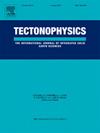Seismic reprocessing of BELCORP-DEKORP 1A reveals deep fault reflections of the Paleozoic Eifel Fold and Thrust Belt in Germany
IF 2.7
3区 地球科学
Q2 GEOCHEMISTRY & GEOPHYSICS
引用次数: 0
Abstract
The Paleozoic Eifel Fold and Thrust Belt is part of the northern Variscan Deformation Front. Due to erosion, parts of its uppermost layers have been removed, enabling direct seismic reflection imaging of its internal deformation pattern in the upper crust utilizing seismic reflection imaging techniques. Reprocessing of the BELCORP-DEKORP seismic reflection line 1A from 1987 reveals previously undocumented structural details when applying state-of-the-art tools such as an improved seismic velocity background model and Fresnel volume migration. Additionally, a detailed analysis of seismic polarities helps to characterize the impedance contrasts of the reflectors at depth. A marked reflector of approximately 80 km length is identified, originating in the Belgian Ardennes Mountains and terminating in the southeast in the Hocheifel Volcanic Field at a depth of c. 12 km. The reflector dips in average with about 8° towards the southeast and has a thickness of approximately 400 m. In many parts, this reflector is characterized by a negative impedance contrast, which can be interpreted as a fault gouge or breccia composed of crushed rock, possibly containing fluids. This large feature is interpreted as the basal detachment zone of a wedge-like structure. A restoration model of this wedge results in shortening of about 22 km. In addition to the main detachment reflector, numerous tectonic features like subsidiary fault strands, synclines, ramps and backthrusts have been imaged. Strong reflectors in the Hocheifel Volcanic Field are interpreted as solidified sills related to the Cenozoic magmatism.
BELCORP-DEKORP 1A地震再处理揭示了德国古生代艾菲尔褶皱和冲断带的深部断层反射
古生代艾菲尔褶皱冲断带是北瓦里斯坎变形前缘的一部分。由于侵蚀作用,其最上层的部分已被移除,因此可以利用地震反射成像技术直接对上地壳内部变形模式进行地震反射成像。对1987年的BELCORP-DEKORP地震反射线1A进行再处理,当应用最先进的工具(如改进的地震速度背景模型和菲涅耳体积迁移)时,揭示了以前未记录的结构细节。此外,对地震极性的详细分析有助于表征反射器在深部的阻抗对比。发现了一个大约80公里长的明显反射体,起源于比利时阿登山脉,在深度约12公里的Hocheifel火山场的东南部终止。反射面东南方向平均倾角约为8°,厚度约为400 m。在许多地方,这个反射体的特征是负阻抗对比,这可以解释为断层泥或角砾岩,由破碎的岩石组成,可能含有流体。这个大的特征被解释为楔状构造的基底分离带。这一楔形的恢复模型结果缩短了约22公里。除主拆离反射面外,还对辅助断链、向斜、斜坡和逆冲等构造特征进行了成像。Hocheifel火山场强反射层被解释为与新生代岩浆活动有关的凝固岩。
本文章由计算机程序翻译,如有差异,请以英文原文为准。
求助全文
约1分钟内获得全文
求助全文
来源期刊

Tectonophysics
地学-地球化学与地球物理
CiteScore
4.90
自引率
6.90%
发文量
300
审稿时长
6 months
期刊介绍:
The prime focus of Tectonophysics will be high-impact original research and reviews in the fields of kinematics, structure, composition, and dynamics of the solid arth at all scales. Tectonophysics particularly encourages submission of papers based on the integration of a multitude of geophysical, geological, geochemical, geodynamic, and geotectonic methods
 求助内容:
求助内容: 应助结果提醒方式:
应助结果提醒方式:


